Every parent strives to cultivate the best qualities in their child, to help them master the necessary skills. Drawing helps children of different ages navigate the world around them, and is also one of the most accessible ways of self-expression. Classes for children 2-3 years old differ significantly from classes with children of other age groups, since at this age there are strict age restrictions.
Drawing with children 2-3 years old in kindergarten according to the Federal State Educational Standard develops the flexibility of hands, fingers, palms, and improves the child’s skills in creating something with their own hands.
Peculiarities of development of children aged 2-3 years
To begin teaching drawing, every parent or teacher should have a good understanding of the peculiarities of children's development at this age. Children should not be required to do something that they cannot do for natural reasons.

Brief description of the development of basic skills:
- Motor skills. At this time, complex coordination begins to form. Children try to catch a ball, hold large objects, and build a tower from several cubes.
By the age of 2.5, they are able to pour liquid from one container to another. At this time, experts recommend actively working on grasping techniques. Brushes, pencils or markers are well suited for developing finger grasping techniques.
- Speech abilities. The age period from 2 to 3 years is one of the peaks of speech development. Children actively expand their vocabulary, begin to repeat complex words, show a desire to construct sentences and conduct simple conversations with the construction of sentences.
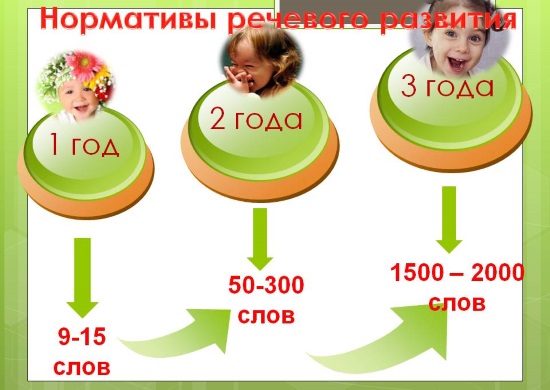
- Development of emotions. Children of this age group have poor control over emotional outbursts. They often show a natural reaction to the current situation and are not always able to control themselves.
- Behavioral characteristics. Compared to children aged 1 to 2 years, these little ones begin to understand their importance as individuals in the world around them. They pay attention to the behavior of other children their age and gradually learn two-way communication.
- Mental development. Children aged 2-3 are characterized by intensive development of attentiveness and observation. Many begin to actively take an interest in various types of creative activities. It is at this age that psychologists and teachers advise starting to conduct classes on the creative development of the child's abilities.
Benefits of Drawing
Famous psychologists and teachers talk about the importance of drawing in children's development. It is not just an interesting activity built in a game form, but a way to learn about the world around us and study ourselves. Such skills are important for children aged 2-3 years.
At the same time, parents or beginning educators need to remember that at the initial stage of introducing a child to brushes and paints, it is necessary to show in detail the basics of creative activity.
But one cannot hope that, having received a pencil and a sheet of paper in their hands, children of this age group will begin to independently use the materials for their intended purpose. Experts advise paying attention to non-traditional drawing techniques. They are in demand when planning drawing lessons with children of this age.
Little ones cannot master classical drawing techniques well enough, as they do not hold a pencil or brush well. Paints at the introductory stage make children want to taste them.
Each teacher is faced with the task of finding a way of joint drawing that will be interesting to the child and will become an incentive for further learning.
The benefits of using drawing techniques in children's development and a description of the benefits received:
| Examples of drawing techniques | Expected result |
| Finger paints, handprints or foot prints | A conscious attitude towards your own body. |
| Poking, dabbing, imprinting | Development of imagination and fine motor skills. |
| Creating sketches and drawings in the traditional way | Targeted development of artistic skills. |
Basics of drawing at 2-3 years old
It is important not only to interest the child in drawing, but also to properly organize the work process. In addition, training should be consistent. You cannot set complex tasks for the child without a detailed explanation of the instructions for them. The optimal option for combining techniques is to start moving from simple, intuitive movements in sketches to more complex ones that help depict volumetric elements.
How to interest a child
Drawing with children aged 2-3 years can be one of the daily activities, continuing the whole course or represent a fragmentary game.
To get your child interested, you can use one of the following methods:
- come up with a story about brushes and pencils that want to show the baby what they can do;
- in the form of a game, suggest drawing what surrounds the child (trees, clouds, puddles, the sun);
- voice the fairy tale plot and at the same time “play” with the resulting characters.
A parent or teacher needs to prepare for the lesson in advance, study the topics of the stories, and select suitable poems or songs.
Organization of the work process
Classes should not last more than 10-15 minutes. The optimal option is to conduct mini-drawing lessons 2 or 3 times a week.
Every day you can continue to introduce the child to the skills of gripping a brush, pencil or felt-tip pen, talk about new activities, show the child pictures, discuss colors. This can arouse interest and provoke anticipation of the next lesson.
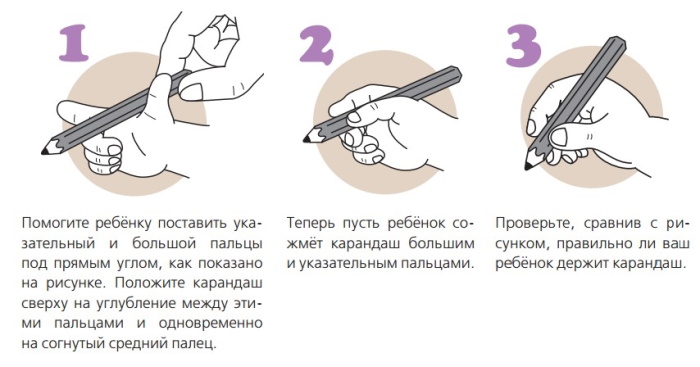
First, you need to teach your child how to hold a pencil or brush correctly. These tools are traditionally held with three fingers. The middle finger should be in the bottom position. Small children often make mistakes at this stage.
They grip stationery incorrectly, which quickly makes them tired and lose interest in the lesson. The grip rules need to be carefully adjusted during the lesson.
A child of 2-3 years old is sensitive to the fact that he is unable to repeat something after an adult, so it is better to prepare several sheets of paper, special napkins, protect clothes with an apron, prepare spare pencils, brushes or felt-tip pens in advance.
Pictures for coloring in 2-3 years
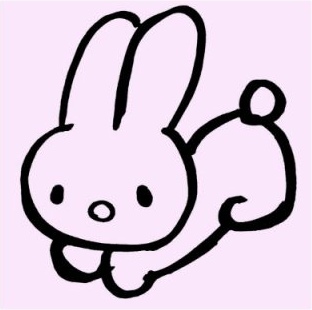
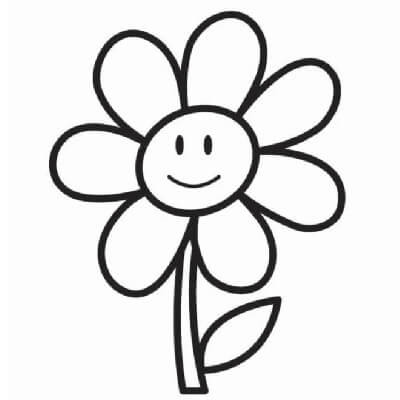

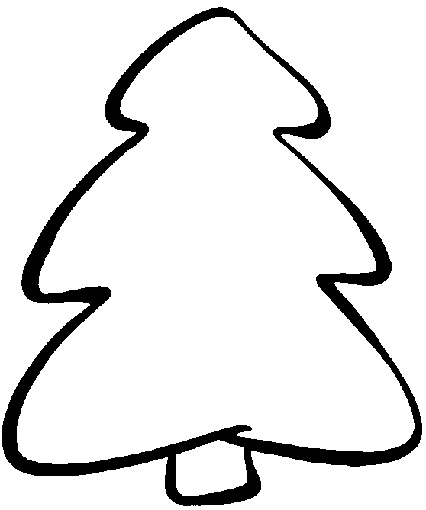
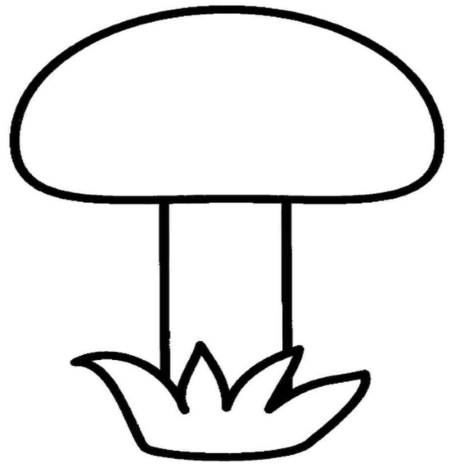

Drawings by contours

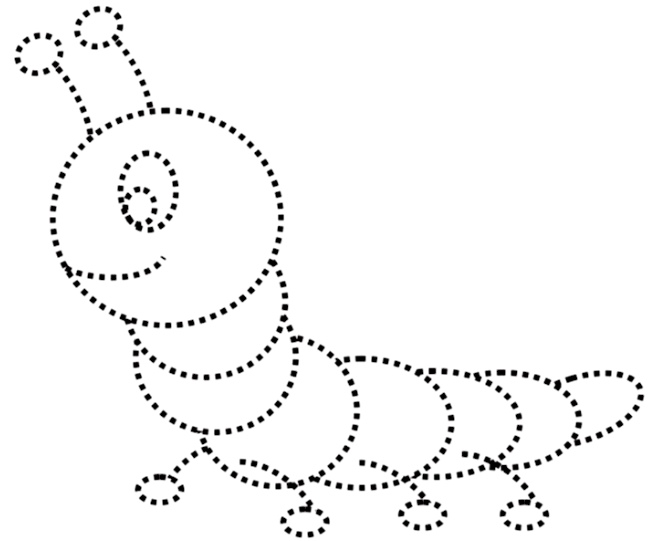

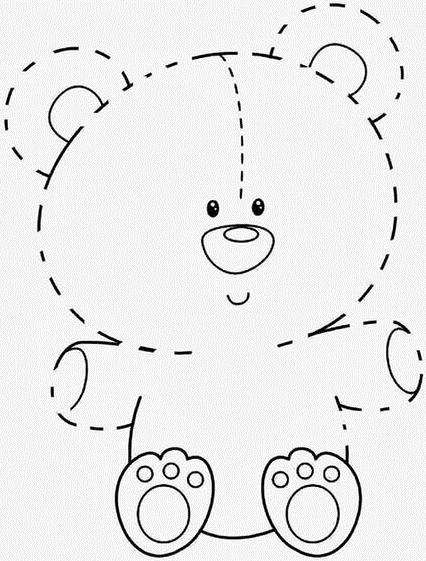
How to teach a 2-3 year old child to draw
Drawing with children 2-3 years old begins with a demonstration of the simplest techniques. First, children are taught to draw vertical lines, and shown the difference between lines drawn with a brush and a pencil.
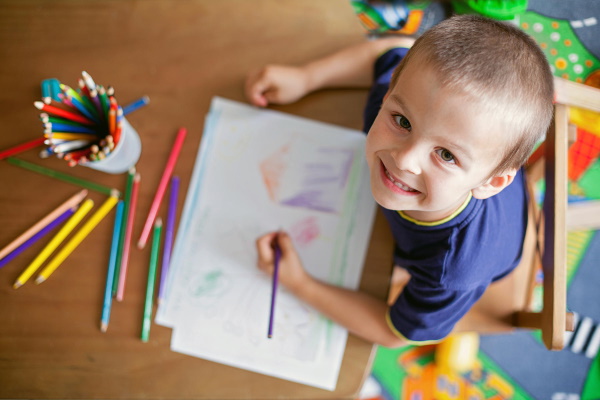
Then they begin drawing horizontal lines. At the final stage, they draw circles and ovals. These are the most important events taken as the basis for organizing the learning process. Short drawing lessons are held with children aged 2-3.
The lessons are united by a course, which experts conditionally divide into 3 large stages:
- Acquaintance. This is a detailed story about the properties of paints, a demonstration of materials, taste and touch tests.
- Imitation. Drawing the simplest lines with the transition from simple skills to more complex abilities.
- Providing independence. At this stage, the child is given the task of putting his own ideas on paper. If the child has difficulty choosing a plot, the adult should carefully guide him.
What topic to choose
To keep the child interested in drawing, it is necessary to formulate the task correctly and build the structure of the lesson. The child's personal preferences are of great importance when choosing a topic.
If he knows and loves Russian folk tales, you can offer him the most common plots as a basis:
- After mastering the initial skills, the child is shown how to draw grass for a goat that went to get milk for her kids;
- together with your parent you can depict the sun warming the animals that live in the little house;
- draw Kolobok and other fairy tale characters.
A win-win option is to depict natural objects. If you ask your child to draw the sun that he saw on a walk, you can play with shades of colors at the same time. To do this, you will have to mix different shades of yellow paint, add red or orange paint.
The result will be an image of different types of sun: a bright morning sun of a straw shade and an orange or red evening sun at sunset. In winter, children are offered to draw icicles, snowflakes, depict snowdrifts with blue paint, draw snowmen or pine cones found in the forest.
Basic drawing techniques for the little ones
Drawing with 2-3 year olds involves implementing unusual ideas and creative techniques. Specialists have developed safe-based materials called finger paints. You can taste them, they wash off clothes perfectly, and they do not leave stains on plastic surfaces.
Painting with paints
Finger paints are an alternative to gouache and watercolors, which children should be introduced to after 4-5 years. Interestingly, finger paints can be used with brushes or hands. The process of dipping fingers in paint and creating traces on paper cannot fail to please a 2-3 year old.
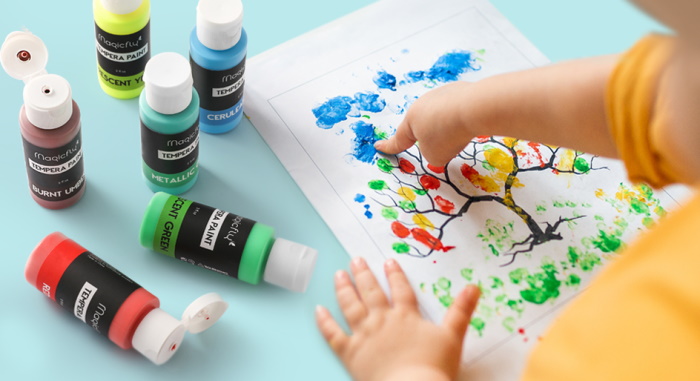
Basic rules for working with finger paints:
- the child needs to be well-rested, not hungry, and ready to play;
- During the first lessons, the number of colors should be limited, offering 1-2 colors;
- the first lessons should not last more than 10 minutes;
- You need to give the child the opportunity to study the properties of the material and get used to new sensations.
Work with finger paints should be finished a little earlier than the child loses interest in them. Image options can be handprints, drawing lines with a finger.
Wax crayons, pencils
Wax crayons and pencils are introduced into classes when the basic concepts have been studied. Wax crayons leave an unusual mark. To learn how to work with them, you will need to master certain skills.
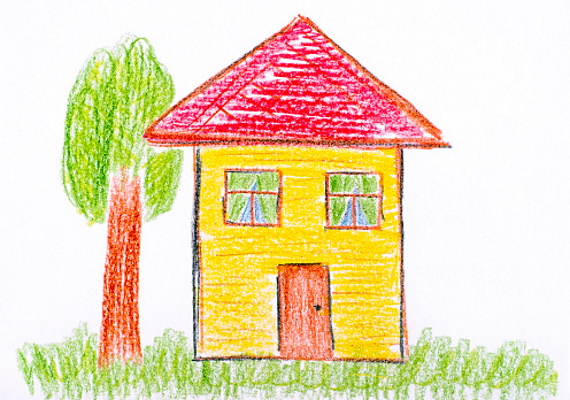
Features of using wax crayons and pencils:
- for classes you should choose triangular pencils of medium diameter;
- the child quickly gets tired due to the need to control the force of pressure, so the lesson should be short;
- It is necessary to choose the right subject for the drawing so that the child can see the result of the work.
Drawing with a poke
The poke method is an unconventional drawing technique that has become widespread when working with children aged 2-3. The simplest plots are selected for the lessons and the sequence of actions is explained to the child.
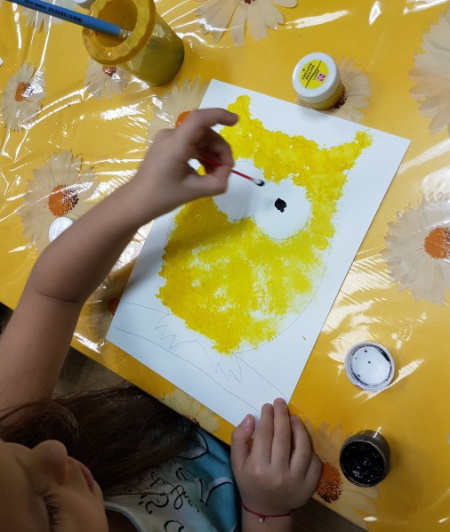
To draw a sun, you will need a sheet of paper, cotton swabs and yellow paint. First, the teacher marks an oval on the sheet of paper that needs to be painted, then, using the demonstration method, when the child's hand is in the hand of an adult, shows what needs to be done.
The stick is dipped in paint and the field is filled with short pokes-dots. As the cotton swab loses its working qualities, it is replaced with a new stick.
By soaking
Dipping is another unconventional technique that is well suited for children aged 2 to 3. It can be started after the child has acquired the first knowledge of paints and holding a brush in the hand.
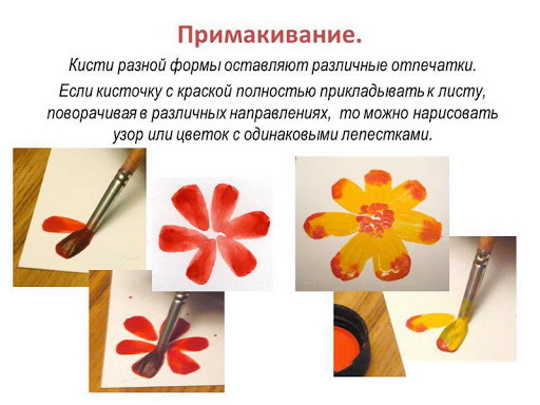
The process consists of several stages:
- First, the brush is dipped into a jar of paint.
- Carefully apply paint to the tip of the brush.
- The brush is placed against the paper, but the line is not drawn; the brush is immediately moved to the side.
The result of the work is a brush mark. With the help of an adult teacher, a 3-year-old child can independently fill in the sketch provided to him with such marks. Each mark is different, it depends on the amount of paint collected on the brush.
Stamps, fingerprints and palm prints
Stamps and imprints are an interesting approach to drawing that all children without exception enjoy. It does not require special skills in working with brushes or pencils. To complete the task, you will need any material that can leave an imprint on paper.
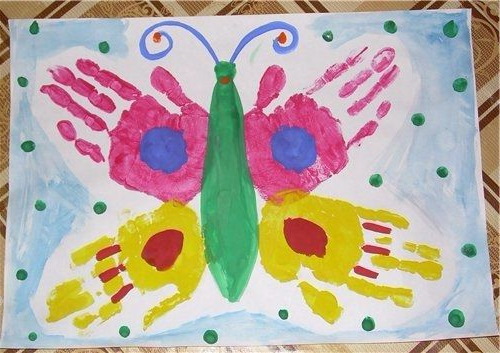
Stamps can be purchased in a store or made by yourself. Textured marks on paper can be left by pieces of wood, halves of fruits or vegetables, textile materials. First, you need to prepare materials for the lesson. If you use citrus fruits, you need to cut them in half and let them dry so that there is no excess liquid on them.
Then the lemon half needs to be completely dipped in paint and transferred to the sheet. After this, the sheet will have an imprint with the fibers that stand out, characteristic of the structure of the citrus. Usually, stamping or creating imprints is so enjoyable for children that an adult can only watch the process and help to eliminate minor violations.
Card index of drawing lessons in preschool educational institutions
Every children's educational institution has its own card index of drawing lessons with children. It is a list of lessons with a description of the techniques used, plot options and the progress of the work.
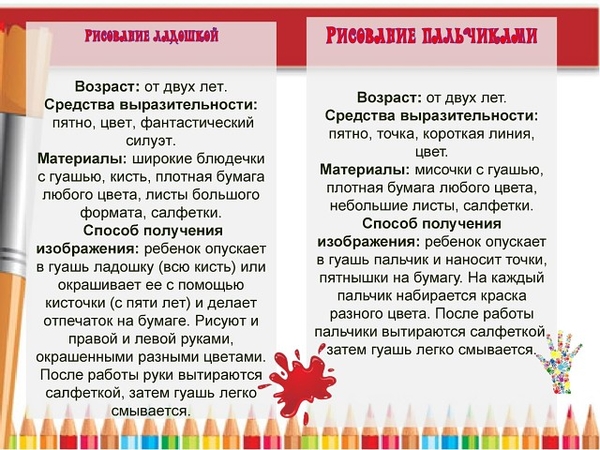
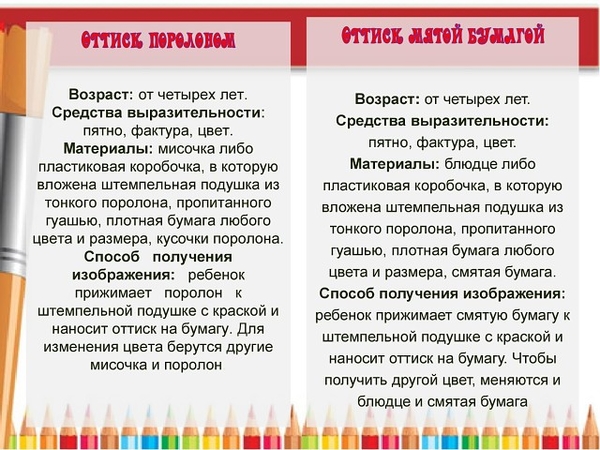
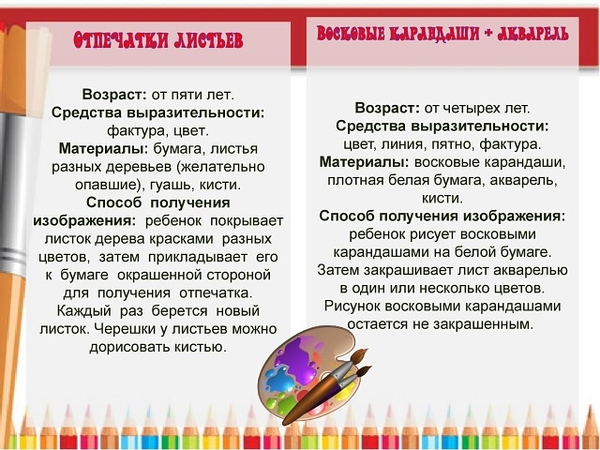
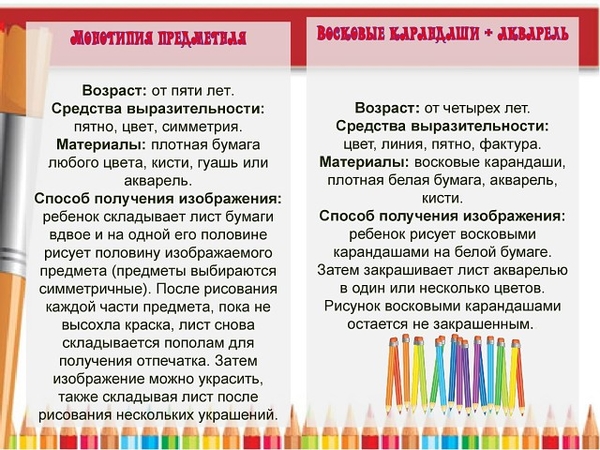
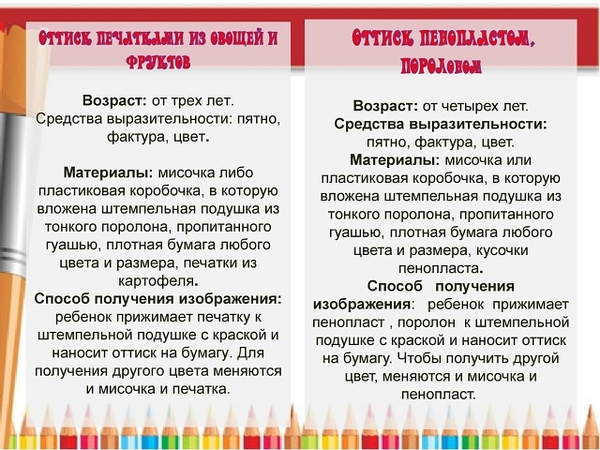
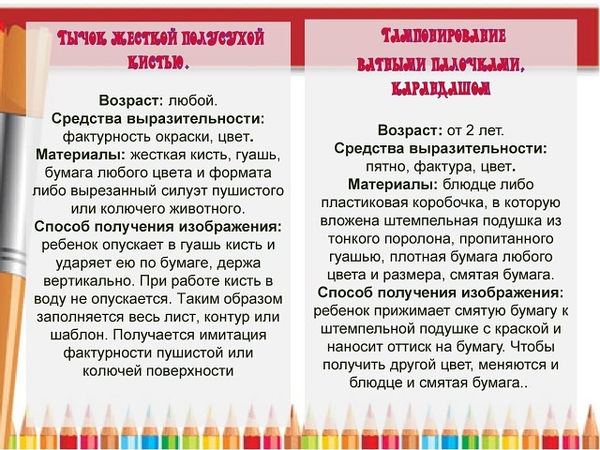
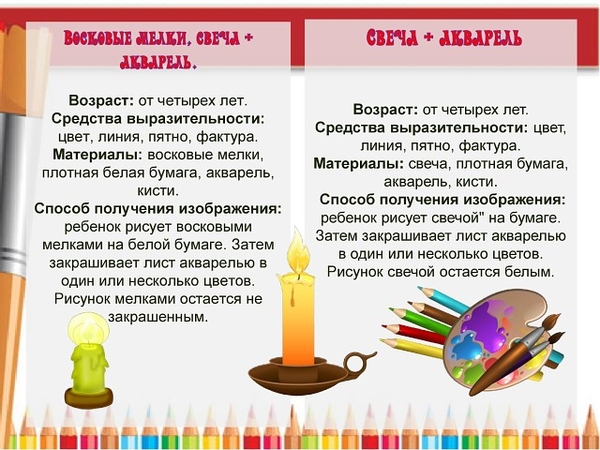
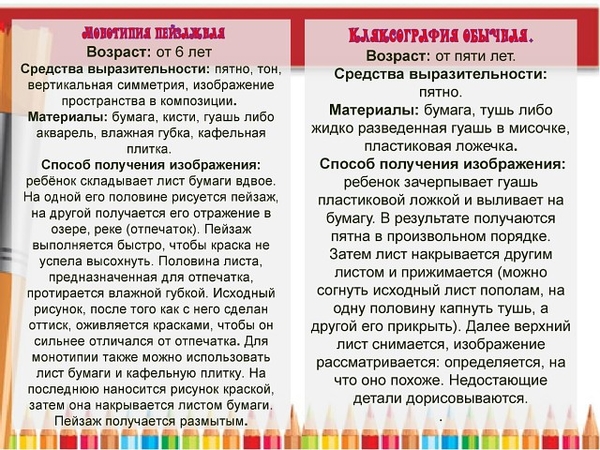

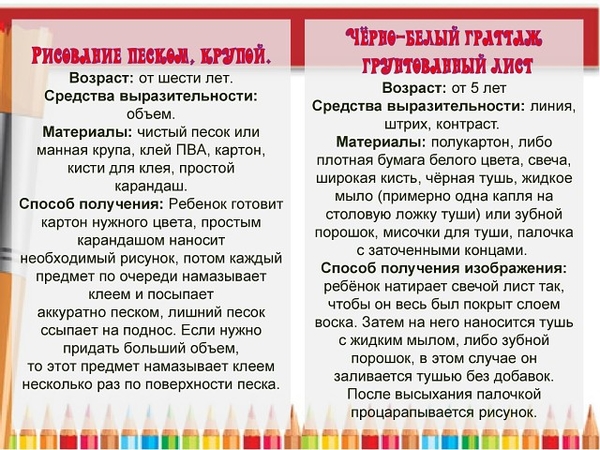
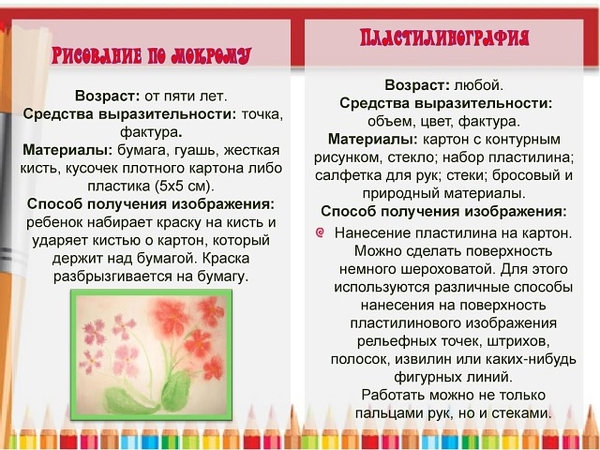
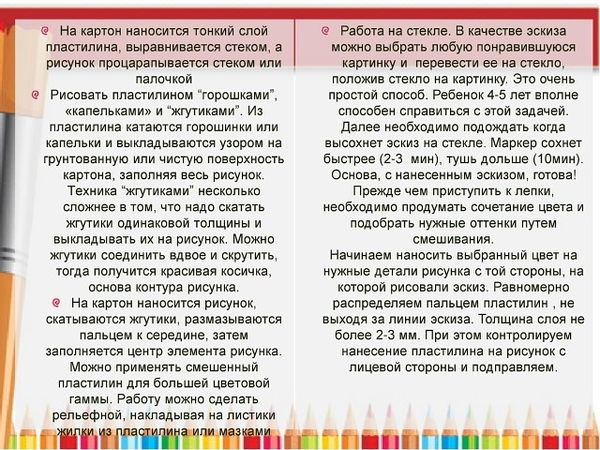
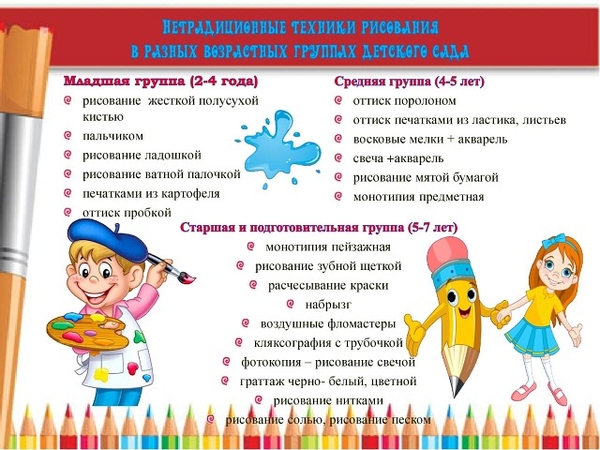
The advantage of using the card index materials independently is the choice of a variety of topics and a step-by-step description of the work process. In addition, each card index contains a list of tasks set before the start of the classes.
The card files are freely available on the Internet; you can download them, print them out and use them for your own lessons or create your own lessons based on them.
Drawing ideas
Drawing with 2-3 year olds is an interesting activity using standard patterns. If the child shows interest in paints and brushes and masters the skills faster than planned, you can move on to the next, more complex stage.
If the child is slow and passive, it is better to repeat the lessons several times with an interval of 2-4 days.
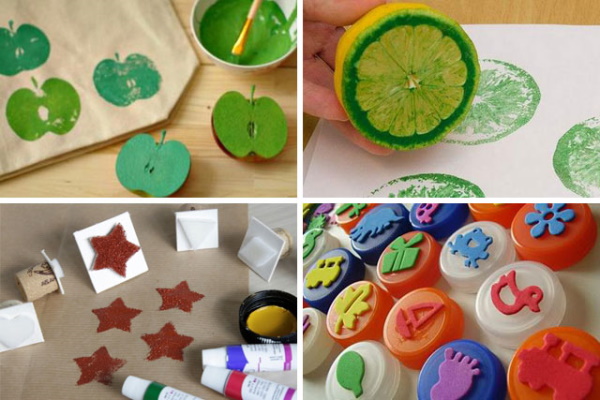
Popular drawing ideas for children aged 2 to 3 years:
- using vertical sticks you can depict fences or grass;
- Droplets are drawn using smooth, rounded lines;
- on the sketch, using vertical lines, draw spines on the hedgehog or rays on the sun;
- by combining horizontal and vertical lines they depict a railway.
After mastering the simplest skills, they begin drawing landscapes using different elements. When the child has mastered the ability to create a circle, it is recommended to devote several lessons to drawing a tumbler. It is better to paint the toy in different ways, using non-traditional approaches.
Recommendations from psychologists and teachers
Experienced specialists recommend avoiding mistakes when creating lesson plans for children. Violating the basic rules can push a child away from drawing, he will start to be capricious and completely lose interest in the process.
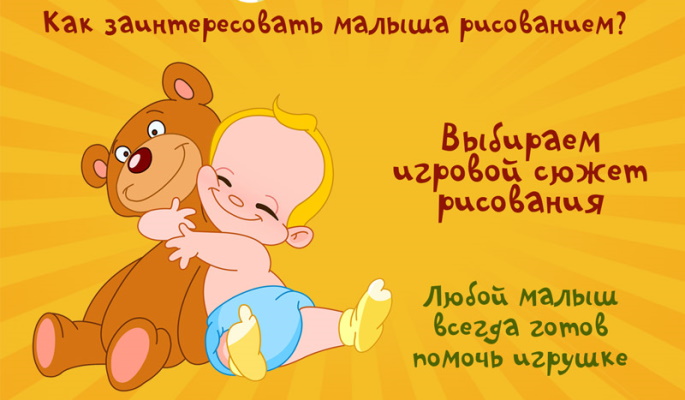
One way to get a 3-year-old interested in drawing, according to psychologists, is to offer to make a handmade gift to someone in your family. During the lesson, you can offer the child to come up with his own signature. This can be a handprint or a symbol created with finger paint.
Recommendations:
- During the lesson, it is necessary to completely minimize the methods of intervention. If an adult shows how to draw a line or leave a print, then he should do it on his own sheet of paper. The child's work area should demonstrate only his own result.
- It is important that during a drawing lesson, the child's attention is fully focused on the proposed task. It is necessary to put away everything that can distract or switch the gaze. Do not use all the colors of the palette at once. Until the child gets used to the colors, it is better to offer him 2-3 options.

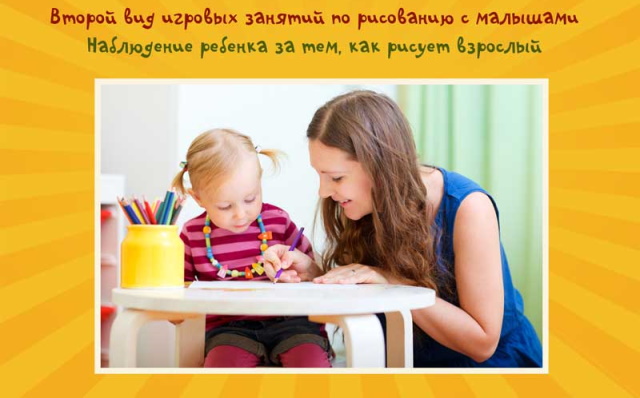
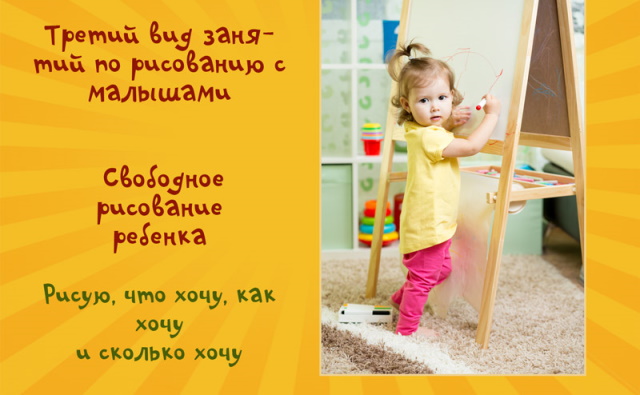
- The last and main requirement for an adult, according to psychologists, is that strict demands should not be made on a child. If the lines do not work out, a dark blot appears on the sheet instead of the expected cloud, there is no need to show a sample and demand perfect imitation.
At this age, it is impossible. The parent must be patient, act as an observer and a patient mentor. Over time, every child will learn to hold brushes and use paints.
Some children perceive creativity as a stimulus for the development of artistic abilities, but for some of them drawing lessons are needed only to better understand themselves and establish relationships with the world around them.
Drawing with kids is a useful and exciting activity. For children aged 2 to 3 years, drawing looks like one of the game techniques. Kids are not yet ready to perceive creative activity as learning, but at the same time they happily master the basic drawing skills and acquire new abilities.
Video about drawing
Drawing with kids 2-3 years old:

You can teach your child to draw using YouTube: https://www.youtube.com/watch?v=_D82TW4SR40
Excellent video, thank you for important, interesting activities with the child. Game moments well maintain the interest of the child. At the end, the drawing and commentary of the girl on the book cause delight. Bravo mom. The books aroused great interest in me. Thank you very much.